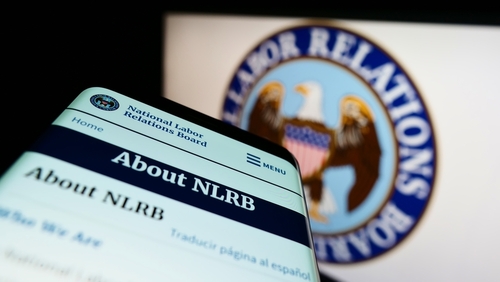Trump's firing of NLRB member could lead to reconsideration of 1935 Supreme Court precedent

A challenge to a 1935 U.S. Supreme Court precedent could be brewing, after President Donald Trump fired a Democratic member of the National Labor Relations Board. (Photo from Shutterstock)
A challenge to a 1935 U.S. Supreme Court precedent could be brewing, after President Donald Trump fired a Democratic member of the National Labor Relations Board.
Fired board member Gwynne Wilcox has said she is “pursuing all legal avenues,” which could lead the administration to argue that Humphrey’s Executor v. United States should be overruled, report Law.com, the Volokh Conspiracy and Bloomberg Law.
The Supreme Court held in Humphrey’s Executor that Congress can prevent a president from removing without cause members of the Federal Trade Commission, a multimember independent agency.
The statute governing the NLRB says its members can be removed “upon notice and hearing, for neglect of duty or malfeasance in office, but for no other cause.” The Trump administration has said Wilcox and NLRB general counsel Jennifer Abruzzo were fired because they were “far-left appointees with radical records of upending long-standing labor law.”
Daniel Wolff, a partner at Crowell & Moring, told Law.com that he thinks that a lawsuit by Wilcox would be “a great vehicle for reconsideration of Humphrey’s Executor.”
“There’s already several Supreme Court justices that have signaled a desire to get the right case to revisit Humphrey’s Executor,” Wolff told Law.com. “I think the day of reckoning is coming.”
The administration could also argue that Humphrey’s Executor doesn’t protect Wilcox because of structural differences between the NLRB and the FTC, said Steve Swirsky, co-chair of Epstein Becker & Green’s labor management relations practice group, in an interview with Law.com.
Members of the NLRB don’t have to be balanced along partisan lines, while the FTC can’t have more than three commissioners from the same political party on its five-member board, Swirsky said.
In tension with Humphrey’s Executor is the June 2020 decision Seila Law v. Consumer Financial Protection Bureau, wrote Jonathan H. Adler, a professor at the Case Western Reserve University School of Law, at the Volokh Conspiracy.
The Supreme Court held in Seila Law that Congress can’t constitutionally impose a for-cause requirement for the removal of the director of the CFPB.
The high court distinguished Humphrey’s Executor, however, noting that the CFPB was headed by a single director, rather than a multimember board, and the single director had significant administrative and enforcement authority.
The administration nonetheless cited Seila Law in its letter justifying Wilcox’s firing, according to Bloomberg Law. The letter argued that NLRB members can be removed because they exercise executive power, and the board isn’t balanced along partisan lines.
Would the Supreme Court overrule Humphrey’s Executor? Administrative law professors interviewed by Bloomberg Law were divided on the likely outcome.
Write a letter to the editor, share a story tip or update, or report an error.



